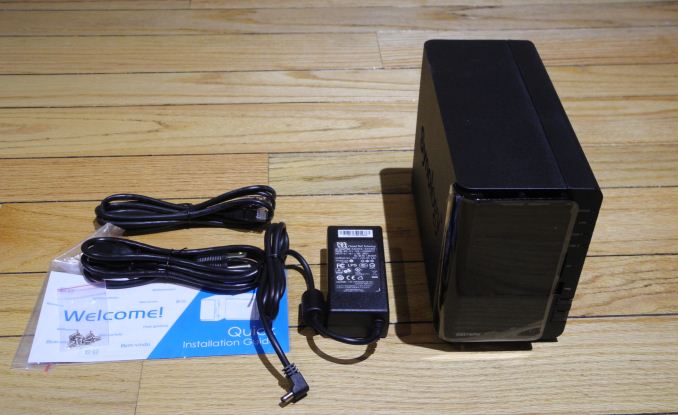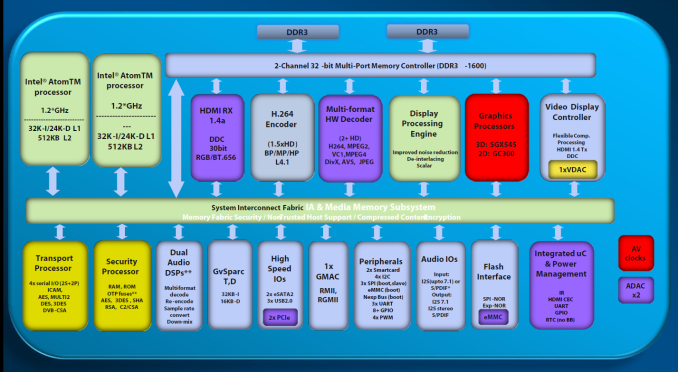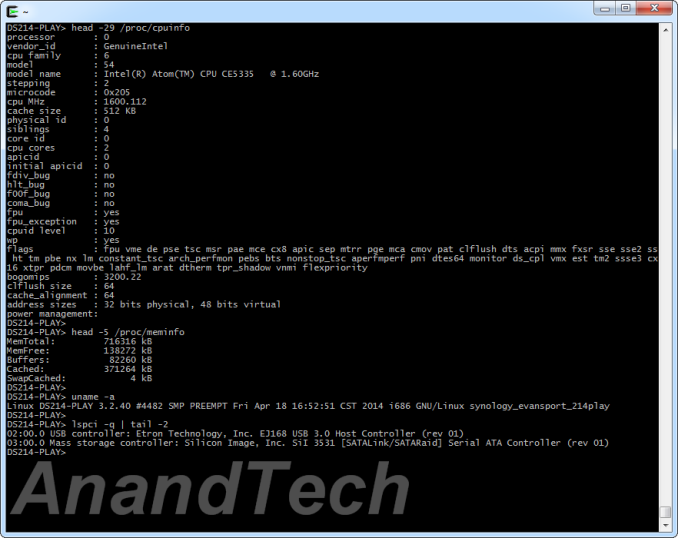Synology DS214play: Intel Evansport Almost Done Right
by Ganesh T S on May 20, 2014 3:00 PM ESTHardware Aspects & Usage Impressions
The industrial design of Synology's 2-bay NAS units hasn't really changed since we last reviewed one in the DS211+. We continue to have the detachable face-plate (a fingerprint magnet) and hot-swap bays (with the hard drives kept in place on the caddies with screws on the side). The contents of the DS214play package are as below:
- Synology DS214play chassis
- 2M Cat 5E Ethernet cable
- 65 W external power supply with US power cord
- Getting Started guide
- Screws for hard disk installation
In terms of external I/O, we have a SD card slot and a USB 2.0 port in the front panel. On the rear, we have two USB 3.0 slots, an eSATA port and a single RJ-45 GbE port. The eSATA port can be used to attach a DX513 5-bay expansion module to provide a total of 7 bays. An important aspect to remember is that the hard drives in the expansion module can't be used for volume expansion, but additional volumes only.
Platform Analysis
The block diagram below gives the layout of the Intel CE5335 SoC. Typically, x86 NAS units come with dual network ports (capable of port trunking), but units based on Evansport (such as the DS214play) don't have that because of the lack of support in the platform. This is acceptable, considering that the unit is supposed to cater to home consumers who want to use it as a media server.
The other important aspect is the available high-speed I/Os. In a NAS platform based on the CE5335, there are two SATA ports and two PCIe 2.0 lanes. There is no native USB 3.0 support in the SoC. Therefore, the DS214play's USB 3.0 support definitely from a USB 3.0 to PCIe bridge. Since the two SATA ports are already being used for the drive bays, it can be inferred that the eSATA port is enabled using a PCIe to SATA bridge. Considering these inferences, it looks like the platform should be able to support all peripherals at full speed (except for the two USB 3.0 ports which talk to the SoC through a single PCIe lane). One option to determine the components on the board would have been disassembling the unit. Fortunately, Synology provides SSH access. The screenshot below exposes some of the hardware aspects of the DS214play.
As expected, the USB 3.0 ports are enabled by the Etron EJ168A USB 3.0 to PCIe bridge, while the eSATA port is enabled by the Silicon Image SiI 3531 SATA to PCIe bridge. TechPowerUp also has a great teardown of the NAS in their review, where they show these components on the board (in addition to the Realtek RTL8211E GMAC for the GbE port and the Genesys Logic GL836 SDIO to USB 2.0 bridge for the SD card slot). A look back at the CE5335 block diagram shows that we have three USB 2.0 ports in the SoC. Only two get used, one for the SD card slot and the other for the front USB 2.0 port.
Setup & Usage
After connection to the network, the unit obtains a DHCP address (even in diskless mode) and could be setup using the web UI at http://<DS214play-IP>. The setup process is straightforward. At least one of the bays needs to be populated. We chose to use the Synology Assistant tool to initialize the NAS (we have used the web interface before in our previous Synology reviews). The firmware (Synology Disk Station Manager - DSM) can be uploaded from a local file in this process. Basic network settings (DHCP / manual static IP) can also be set up using the tool. After a restart, the rest of the configuration is handled through the web interface.
Upon logging into a freshly installed DSM, the user is provided with various options to aid in setup of external access to the NAS. Synology allows its users to create a MyDS account on their servers. The NAS units themselves are provided with a unique 'QuickConnect' ID. A MyDS account can have multiple QuickConnect IDs associated with it. The combination of this ID and a MyDS account helps Synology operate a relay service for access to the NAS from an external network. Users can opt to not register for these, but still enjoy external access if they forward the appropriate ports on their router. We will cover more on this in a later section.
DSM 5.x, in keeping up with the previous versions, is undoubtedly the gold standard to which all other NAS interfaces must measure up to. The combination of a desktop-style interface and a multi-tasking UI with support for desktop widgets make it a pleasure to use. Backing up the eye-candy is a rock-solid Linux-based storage management system and a wealth of applications (both Synology-created and third-party developed). Exploring all the features of DSM 5.x deserves a separate piece by itself. However, we will take a slightly different approach. In one of the later sections, we will look in detail into the external access and multimedia features of DSM 5.x (an area where the DS214play is supposed to excel). We have some more Synology reviews in the pipeline and those will be used to look at the other features.
Our testing sequence started with the insertion of a single disk and configuring it in Synology Hybrid RAID (SHR). For a single disk, it is effectively a JBOD configuration, but the addition of a second disk triggers a migration to RAID-1. While migrating to the new RAID level on the DS214play, the data remained online (as expected) and the process got done without any hitch. We tested RAID-1 rebuild by yanking out a disk during operation and re-inserting it. The rebuild process was also uneventful. On the whole, we were very satisfied with the unit's handling of storage operations (including handling of disk failures).





































45 Comments
View All Comments
ganeshts - Tuesday, May 20, 2014 - link
As I mentioned in the review's Video Transcode section and also in the concluding remarks, Plex has never cared about hardware acceleration. So, yes, you are right - no HW transcode with Plex on any Evansport platform ; Only bet for hw transcode amongst NAS vendors is Synology's DSM -- just wish it was more stable :)Aikouka - Tuesday, May 20, 2014 - link
Ah, apologies because I hadn't gotten to those sections yet when I made my comment. I don't know if it's necessarily an issue of PLEX not caring, but I assume that migrating to a new version of FFMPEG isn't a simple task (I read a post from an employee saying that they use a custom version). So, if I had to guess (note: I have no affiliation with PLEX; I just read the forums sometimes), I assume that they want to wait until there's a more pressing reason to upgrade the codec.Although, I hope they upgrade it soon, because I've found some annoying crash-to-desktop issues with stylized subtitles in the Windows version of PLEX Home Theater. In one instance, not even Media Player Classic: Home Cinema could handle it, but in the other, it played fine.
imaheadcase - Tuesday, May 20, 2014 - link
"Network throughput can't be it (I get 900Mbps over my home network moving files between PCs)."Right..I ditched my WHS and never looked back. Nothing it offered can't really be done with these. Unless you got some weird custom software you like to run.
imaheadcase - Tuesday, May 20, 2014 - link
"Network throughput can't be it (I get 900Mbps over my home network moving files between PCs)."That means nothing when you are limited to hardrive speed fyi. You can have a Fiber link between PCs and still limited to slow HD on server.
wicketr - Tuesday, May 20, 2014 - link
You spent time building your rig, right? How much do you value your time? $50/hr? $100/hr? I'm guessing between assembling your rig and configuring it the way you want, you probably spent 5+ hrs. If your time is worth anything of significance, then the cost of your set up far exceeds the cost of a NAS.Additionally, all the features of the mobile app ecosystem are non-existent for a home setup.
A NAS is simply for people that want a easy data storage device that requires little/no time to setup, and offers a multitude of features for access to that data. It's NOT meant as a full blown server. It's a NAS. Even medium/large companies use them for those benefits of simplicity.
bsd228 - Tuesday, May 20, 2014 - link
bzontins - people are paying for a smaller, lower power, turn key solution. You can get close to the size with the HP Microserver, though until the Gen 8 the cpu performance was not much better than the athlons but with much higher power draws. Until sandy bridge, general purpose cpus were too power hungry. The use of HW acceleration for transcoding is a pretty nice feature of this model, and if that continues, could turn the tide.turn key is worth a lot to many people, either because they don't know how to do it themselves, or because they don't want to. As the number of apps increased for these boxes, the need for running solaris or linux is somewhat diminished.
easp - Thursday, May 22, 2014 - link
I hear ya. I like the theory of trading money to save myself time, except for stuff like this, I always end up doing it myself. I've even purchased cheap two drive NASs (ZyXel NSA 320) and then gone to the trouble of running debian on them.I just bought a mini-ITX Kabini board to build a new, faster NAS. I wish their were better options on compact 2 & 4 drive cases and low power PSUs. I prefer having two devices in different parts of the house, with one backing up the other, and I don't want to stuff a big video card in it, so the bigger cases are overkill.
richricard - Tuesday, June 17, 2014 - link
I'm a bit late to the party here but I'll stick my nose in anyway. I've spent many years building countless machines of all shapes and sizes, I'm a programmer by trade, and I'd even go so far as to say I enjoy working with complex networks. But you couldn't pay me the world to change my Synology for any other NAS. Certainly the open source stuff I've looked at pales in comparison to the DSM.If the hardware specs are all you're weighing up then you're missing the point. Fully 50% of what your spending your money on when you buy a Synology is the OS and the apps that come with it. It's just incredible. You really just have to sit down and use one to see how simple, fully featured, and stable they are.
I guess the bottom line for me though (and this may sound a little simplistic), is that they just work. The last thing I want to do when I get home at night is start messing around with a server, and I've never had a single issue in the 6~7 years I've been using Synology's products.
I've also convinced quite a lot of friends and colleagues of their virtues and not one has been the least bit disappointed about buying one.
I'm currently on my 2nd Synology and am considering moving to the 214Play, solely because I want x86 to run some bits on, but my 212+ is a shiner as well!
imaheadcase - Tuesday, May 20, 2014 - link
These are made not for idiot proofing, they are made to just work. I've had mine sitting in a spare room for 2 years and has never needed to even go look at it. (4 unit 12TB) data for media.It streams to My TV from XBMC/Couchpotato/SABnsbd anything I throw at it, stores movies/music/etc without a hickup.
Many businesses also have these for ease of use.
The only difference a custom one offers is just to say you made it, it can't do anymore really than these units can. Or if it can, its just something that caters to YOU and not really other people. You don't need tons of ram for these system to get jobs done (I had a WHS original with only 512megs did all what this can do), and CPU can handle it just fine.
imaheadcase - Tuesday, May 20, 2014 - link
Can't figure out how to edit, but you can also run TONS of apps with these, even ones not listed you can install on the linux side of these. you can run plex server/website/mumble server/etc.